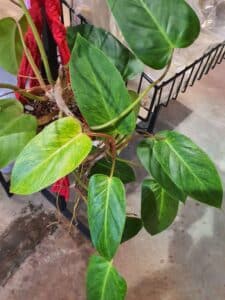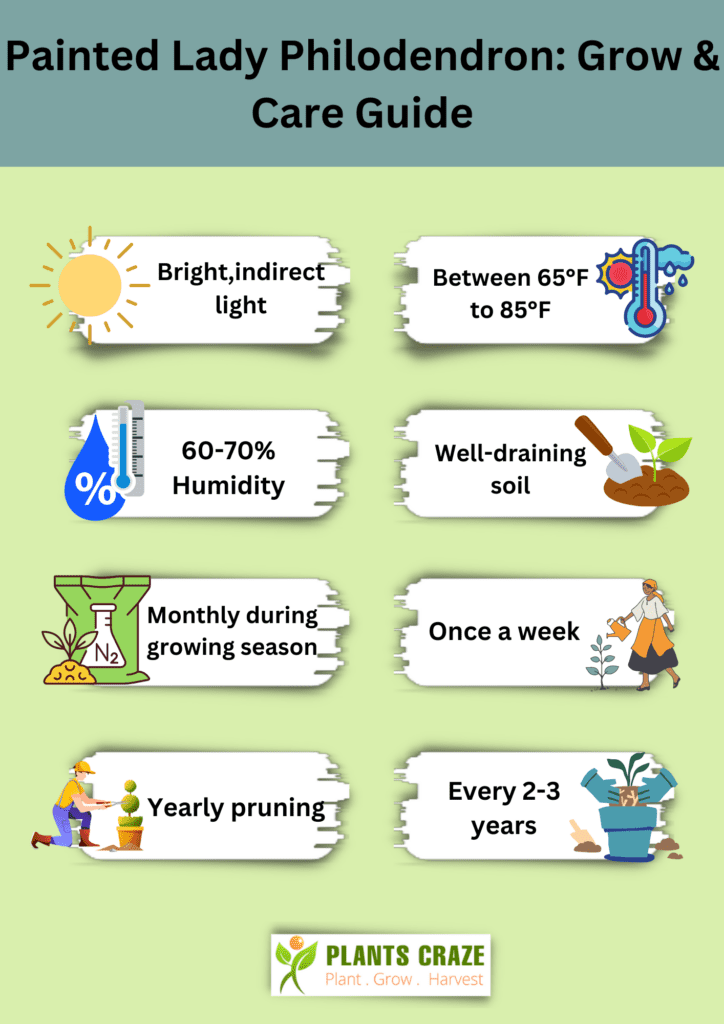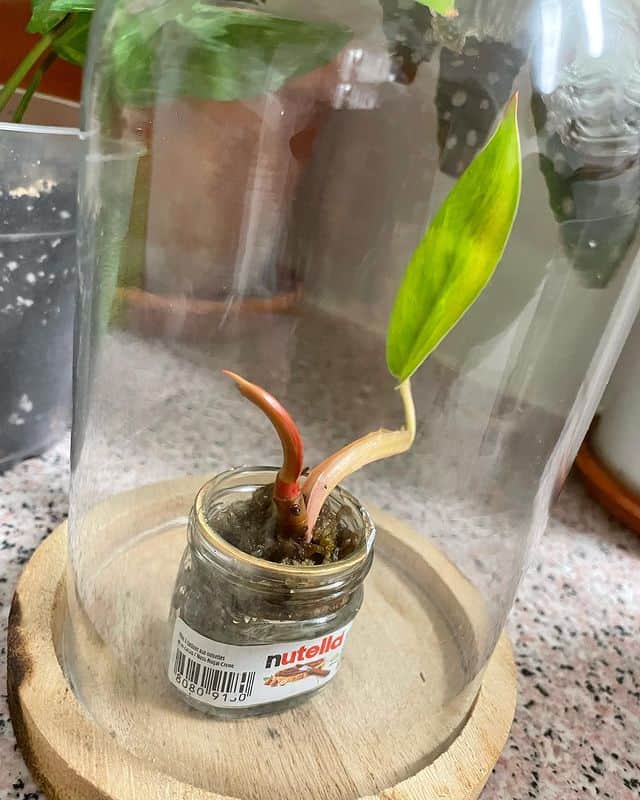Someone who has been into collecting exotic plants can relate to how heavy the Painted Lady Philodendron is for your pocket.
You would want to treasure the Philodendron to its fullest.
But before you rush to bring a Painted Lady home, a detailed insight into the care, propagation, and growth pattern is essential.
Table of Contents Show
Overview of Painted Lady Philodendron
The chartreuse foliage of Painted Lady is an amalgamation of two-parent, Philodendron Burgundy and Philodendron Emerald Queen.
| Indicators | Identity |
|---|---|
| Scientific name | Philodendron erubescens |
| Common name | Painted Lady Philodendron |
| Native | Caribbean and Colombia |
| Family | Araceae |
| Nature | Tropical |
| USDA | Zones 9-11 |
| Plant Type | Variegated Climbing |
| Growth Size | 2-5 Feet |
| Spread | 1-1.5 Feet |
| Leaf Size | Up to 6 inches |
| Flower | Small white and green colored flowers. |
| Bloom Time | Late spring to mid-summer |
| Availability | Rare Greater demand than supply |
| Toxicity | Toxic to pets |

Where to Buy Painted Lady Philodendron?
Painted Lady Philodendron is a very rare aroid. Every website or store that sells this plant adds “rare” to indicate its rarity.
Rare things are expensive. Such is the case with this plant. Its price ranges from $30 for cuttings to $400 for the grown plants.
But trust me, this plant’s beauty will not let you fret over the money you spend.
| Places to Buy | Delivery Period |
|---|---|
| Garden Goods | Within a week |
| Ariodsale | Within 10 days |
| Plant Circle | 1-3 days if you reside in Germany, 3-10 days outside Germany |
| Nursery buy | 5-7 days |
| Foliage Dreams | Upto 6 days |
Painted Lady Philodendron: Ultimate Care & Growing Guide
“Philo” means love/affection in Greek, and “Dendron” means Tree. In their natural habitat, they love to grow on trees and require support.
Look at the essential requirements and optimum conditions for the plant to grow.

1. Adequate Sunlight and Temperature
Being a tropical plant, the Painted Lady Philodendron loves bright but indirect sunlight.
But, it would be best to ensure that the sun is not scorching, or it may burn the beautiful foliage of the plant.
These plants depend on and live under the shade of other big trees in their natural habitat. So keeping them under shades on the patio or indoors would be good.
The plant leaves can lose color and get sunburned in excess light.
When the light they get is low, the plant growth will slow down, and the leaf’s size will diminish to a greater extent.
The plant will grow towards the source and, thus, be leggy in search of the light source.
If they do not get adequate light, they won’t produce the required energy, which results in slow growth.
Even though the plant is affected by light intensity, it can do well in medium light and indoor fluorescent or grow lights.
2. Watering & Humidity
Philodendron Painted Lady is among the plant that enjoys a little dry condition between each watering and humidity.
Since the Painted Lily Philodendron is not a succulent plant, it dislikes dry soil and loves to root in a moist substrate.
Hence, before scheduling the watering, finger-test the soil to ensure proper dryness to prevent problems invited by overwatering.
If an inch of the finger comes dry, rush toward the plant with a watering can.
In contrast, underwatering in plants weakens the root and stem due to obstructed transfer of nutrients during photosynthesis.
Solve the above problem by bottling the plant and letting them decide their drinking limit.
And to increase the humidity content in the air, use a room humidifier or simply group the Philodendron with other house plants like Aglaonema, Begonia, and Pothos.
3. Proper Soil & Fertilization
Painted Lady Philodendron prefers well-draining, porous soil with pH 6.1 to 7.3 enriched with organic nutrients.
A lightweight soil mix retains enough moisture and lets the weak root system of the plant develop without any obstacles.
You can use a slow-release fertilizer three to four times a year to let the plant “take it slow” during the dormant winter.
Meanwhile, if you use commercial soil mixes (specially formulated for orchids) like Sun Bulb Orchid Mix and Miracle-gro, feed only after 4-5 months for the mixture to be pre-enriched to avoid overfertilization.
If you overfertilize the plant, the leaves may look burned, and the edges may turn brown. The plant’s growth may slow down, and eventually, the plant may die.
The plants will lose their natural color, and lesions will appear on the root and stem if you under-fertilize them.
Pro Tip: Fertilize the plant 6 inches away from the base while fertilizing.
4. Potting and Repotting
The Painted Lady has firm and well-established roots, so it doesn’t require frequent repotting.
Meanwhile, make sure the pot suffices proper drainage or drill drain holes to avoid issues with the growing roots.
Moreover, only repot the plant when it is in the “growing phase,” i.e., spring or early summer.
5. Occasional Pruning
Painted Lady Philodendron doesn’t require much pruning as the plant grows slowly compared to other indoor plants.
You need to look for the unhealthy and diseased sections in the plant and remove them before the damage becomes inevitable.
Aphids, mealybugs, and scales are the primary pests underneath your leaves. Before pruning, try haunting the pest invasion with high-pressure water or neem oil.
If the leaves and stem have gone brown and there is no going back, prune from the node’s base.
Painted Lady Philodendron: All About Growth
The Painted Lady Philodendron starts with beautiful foliage and retains its beauty as it grows.
The main attraction for this plant is its heart-shaped leaves, with yellow and little green spots growing as long as 6 inches long. The yellow color of the leaves changes to green as the plant ages.
Further, the stem flaunts bright pink with red petioles, just like the stem of the Pink Princess Philodendron, and the plant takes nearly five years to reach its full potential.
The painted Lady Philodendron rarely bears flowers. The Philodendron flowers are white or green.
It would be better to cut off the flowers as they take up all the resources required for the flower and have an unpleasant smell.
The flowers bloom in late spring to mid-summer.
As it is a semi-climbing plant, you may need to add some stakes for its support if it is indoors. If it is outdoors, your plant will find support on its own.
Toxicity of Painted Lady Philodendron
The beauty of these vining aroids comes with the toxic effect hidden behind them.
These oxalate crystals are the plant’s defense mechanism against external anomalies.
However, the needle-like crystals penetrate the tissue, irritating the eye and throat on chewing and biting.
The symptoms of toxicity in dogs and cats elevate into drooling, pawing, oral discomfort, and vomiting in do.
As a precaution, keep this plant away from small kids and your pets.
And in case of emergency, immediately contact your vet nearby or any of the hotlines below.
Propagation Method for Painted Lady Philodendron
Painted Lady Philodendron can be propagated via Stem Cuttings and Air layering.
I prefer propagation via stem cutting as it is easy and simple.
Being one of the rarest indoor plants, you would like to have many of these plants in your household.
On top of that, this plant’s beauty makes you want to multiply it as much as possible.
Let’s look at the things you should consider before propagation.
| Materials Required | Purpose |
|---|---|
| Gardening Knife | To cut stem |
| Gardening Gloves | To be safe from scales |
| Painted Lady Philodendron Potting Mix | Potting Medium |
| Rooting Hormone | For optimized growth |
| Ceramic Pot | Best for Painted Lady Philodendron |
Propagation via Stem Cuttings
In Soil Medium
- Choose a stem growing from the main stem with at least two or three leaf nodes and cut it with a sterile pair of scissors. Ensure the cut piece is at least 4 to 6 inches.
- Prepare an appropriate potting mix with sphagnum peat moss and perlite.

- Put the freshly cut stem in a rooting hormone and then the prepared mix.
- The roots will develop after three to four weeks. Take good care of it and grow yourself a beautiful household plant.
In Water Medium
- From the same method as above, choose the right stem.
- Keep a jar of water overnight to eradicate all the chlorine content. This will also bring the water to room temperature.
- Place the stem in a jar of water. Ensure you remove the lower leaves and no leaf is submerged in the water.
- Leave at least 1-inch space on the top of the water vessel and keep it away from direct sunlight, or the root will develop algae.
- Change the water every two to three days.
- The root will start to form in 2 to 3 weeks. Once the roots are 3 to 5 inches long, they can be transferred to the soil.
Propagate via Air Layering
This is one of the most interesting propagation methods. You can propagate the plant without cutting it from the mother plant.
- Prepare sphagnum peat moss. Soak the moss in water one hour before starting the process.
- Choose a healthy stem and wrap the peat moss around the node.
- Use plastic sheets to wrap the peat moss.
- Keep a small hole for air circulation, and do not wrap any leaves in the process. The leaves may rot.
- Mist the moss ball regularly to keep it moist.
You’ll see roots in 2-3 weeks.
Further, unwrap the ball and remove the moss around the roots. Cut below the node and take the cutting. Make sure that the cutting has at least two leaves in it.
Put the cut in a transparent pot with potting mix and properly care for it.
FAQ About Painted Lady Philodendron
Is Painted Lady Philodendron Variegation Stable?
The beautiful pattern and the colors on the leaves of the Painted Lady Philodendron are there to stay.
Yes, the variegation of the Painted Lady Philodendron is stable.
Are Painted Lady Philodendrons Expensive?
Painted Lady Philodendron is considered expensive, and if you are low on budget for house plants, you’ll get “Painted Lady Philodendron” without the “-ted Lady Philodendron.”
Because variegation is a rare mutation in these plants, variegated Philodendrons are more expensive than other species.
It starts from $25.22 on Etsy to about $400.
From Editorial Team
Conclusion!
More than anything else, stalk your Painted Lady Philodendron with a sphagnum moss pole under indirect light and higher humidity for an enhanced growth rate.
Be happy. Get a Painted Lady Philodendron!

2 comments
very good article about Philodendron Painted Lady, i love it. thank you
Thank you so much. Be sure to check out my other articles as well.